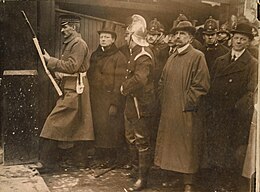Siege of Sidney Street
The Siege of Sidney Street, or the "Battle of Stepney", was a notorious gunfight in London's East End on 3 January 1911.



It happened after a jewellery robbery went bad two weeks before. Three policemen had been killed, and others wounded, and one of the gang was also killed. This event is known as the Houndsditch murders.
The gang were said to be international anarchists led by Peter Piatkow, a.k.a. "Peter the Painter". It is still not clear who their leader actually was.
The end took place at a house in Sidney Street, where word came that a gang of foreigners had moved in. In the fire that ended the siege, one fireman and two robbers died. The fates of other members of the gang, and its leader, are not known.
The Houndsditch murders
changeOn 16 December 1910, a gang of Jewish immigrants attempted to break into the rear of a jeweller's shop at 119 Houndsditch.[1] A nextdoor shopkeeper heard their hammering, and told the City of London Police (in whose area the shop was). Nine unarmed officers — three sergeants and six constables (two in plain clothes) — moved towards the jewellers.
Sergeants Bentley and Bryant knocked at the door of No. 11 Exchange Buildings, behind the jeweller's shop. The gang's leader, George Gardstein, opened the door, but when he did not answer their questions they assumed he did not understand English and told him to fetch someone who did. Gardstein left the door half-closed and disappeared.
The house had a single ground-floor room, into which the front door directly opened, with a staircase leading to the upper floors on the left, and a door to the open yard at the back on the right.
Growing impatient, the two sergeants entered the house to find the room apparently empty, before they became aware of a man standing in the darkness at the top of the stairs. After a short conversation, another man entered through the yard door, rapidly firing a pistol, while the man on the stairs also started shooting.
Both officers were hit, with Bentley collapsing across the doorstep, while Bryant managed to stagger outside. In the street, Constable Woodhams ran to help Bentley, but was himself wounded by one of the gang firing from the cover of the house, as was Sergeant Tucker, who died almost instantly.
The gang then attempted to break out of the cul-de-sac, Gardstein being grabbed by Constable Choate almost at the entrance. In the struggle Choate was wounded several times by Gardstein, before being shot five more times by other members of the gang, who also managed to hit Gardstein in the back. They then dragged Gardstein ¾ of a mile to 59 Grove Street, where he died the next day. Constable Choate and Sergeant Bentley died in separate hospitals the same day. An intense search followed, and a number of the gang or their associates were soon arrested.
The Siege of Sidney Street
changeOn 2 January 1911, an informer told police that two or three members of the gang, possibly including Peter the Painter, were hiding at 100 Sidney Street, Stepney. The police were worried the suspects were about to flee, but expected heavy resistance to any attempt to capture them. On 3 January, two hundred police officers cordoned off the area and the siege began. At dawn the battle started.
The defenders, though heavily outnumbered, had better guns and stores of ammunition. The Tower of London was called for backup, and word got to the Home Secretary, Winston Churchill. Churchill arrived on the spot to see the situation at first hand, and to offer advice. Churchill authorised calling in a detachment of Scots Guards to assist the police.
Six hours into the battle, and just as the field artillery piece that Churchill had authorised arrived, a fire began in the building. When the fire brigade arrived, Churchill refused them access to the building. The police stood ready, guns aimed at the front door, waiting for the men inside to attempt their escape. The door never opened. Instead, the remains of two members of the gang, Fritz Svaars and William Sokolow (both were also known by numerous aliases), were later discovered inside the building.
No sign of Peter the Painter was found.[2] Besides the three policemen, a London firefighter also died of his injuries.[3]
References
change- ↑ Face has changed but fear remains Times Higher Education, 27 June 2003
- ↑ Siege of Sidney Street — 1911 (Metropolitan Police history) accessed 4 Feb 2008
- ↑ BBC news
Further reading
change- The Houndsditch murders and the Siege of Sidney Street, Donald Rumbelow. ISBN 0-491-03178-5
- The Battle of Stepney, Colin Rogers. ISBN 0-7091-9146-4